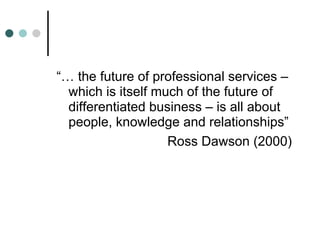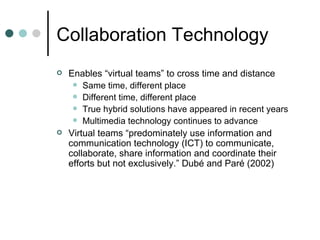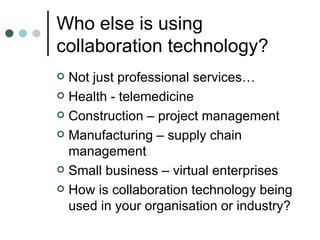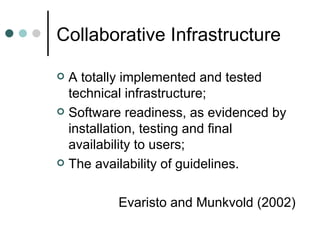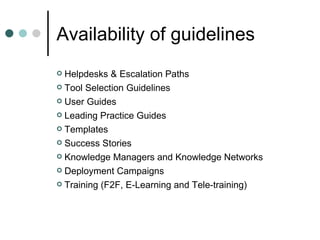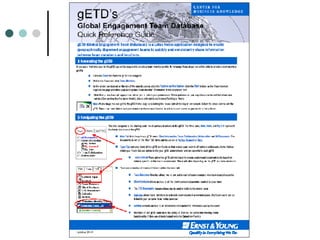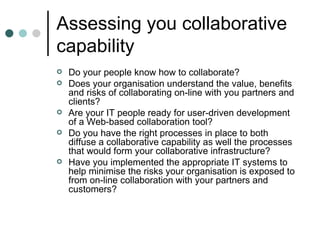Supporting collaboration at Ernst & Young
- 1. Supporting collaboration at Ernst & Young James Dellow KM Challenge 2004
- 2. “… the future of professional services – which is itself much of the future of differentiated business – is all about people, knowledge and relationships” Ross Dawson (2000)
- 4. Collaboration Technology Enables “virtual teams” to cross time and distance Same time, different place Different time, different place True hybrid solutions have appeared in recent years Multimedia technology continues to advance Virtual teams “predominately use information and communication technology (ICT) to communicate, collaborate, share information and coordinate their efforts but not exclusively.” Dubé and Paré (2002)
- 5. Who else is using collaboration technology? Not just professional services… Health - telemedicine Construction – project management Manufacturing – supply chain management Small business – virtual enterprises How is collaboration technology being used in your organisation or industry?
- 6. Collaborative Infrastructure A totally implemented and tested technical infrastructure; Software readiness, as evidenced by installation, testing and final availability to users; The availability of guidelines. Evaristo and Munkvold (2002)
- 7. What are guidelines? Guidelines are crucial “since this paradigm of team working is relatively new and fraught with uncertainties”: Training on the effective, integrated use of electronic collaboration tools The allocation of roles and responsibilities Managing trust Routines and workflow Managing cultural differences Evaristo and Munkvold (2002)
- 8. “ The type of ICT available to a team can facilitate or hinder effective communication among team members… The mix of available ICT for a specific situation is thus critical to ensure effective communication.” Dubé and Paré (2002) How do people in your organisation know what collaboration technology to use?
- 9. Software Risk in Virtual Teams The Web has changed software With traditional application development, knowledge about software risk usually resides with I.T. specialists Some of the risk areas include: Planning and Development Functionality Information Security
- 10. A globally dispersed organisation with over 100,000 people located in more than 141 countries Teamwork is a core value of our firm E&Y provides 22 standard technologies to enable virtual teams, that include: E-mail, IM, Global V-mail, Tele-, Web- and Videoconferencing 1,000s of internal Lotus Notes “project team” databases and 100s of Web-based collaboration spaces shared with our clients Plus other EY/KnowledgeWeb tools Virtual Teams at E&Y
- 11. Availability of guidelines Helpdesks & Escalation Paths Tool Selection Guidelines User Guides Leading Practice Guides Templates Success Stories Knowledge Managers and Knowledge Networks Deployment Campaigns Training (F2F, E-Learning and Tele-training)
- 16. E&Y’s collaborative infrastructure Globally standardised set of tools Center for Business Knowledge TM Service line support groups Knowledge/tool managers Champions and sponsors
- 17. Assessing you collaborative capability Do your people know how to collaborate? Does your organisation understand the value, benefits and risks of collaborating on-line with you partners and clients? Are your IT people ready for user-driven development of a Web-based collaboration tool? Do you have the right processes in place to both diffuse a collaborative capability as well the processes that would form your collaborative infrastructure? Have you implemented the appropriate IT systems to help minimise the risks your organisation is exposed to from on-line collaboration with your partners and customers?
- 18. Assessing you collaborative capability Is your technology infrastructure adequately prepared to support a Web-based collaboration tool? Do protocols exist for testing the on-line workspace before collaboration begins? What data, information and knowledge do you intend to share on-line? Are guidelines available for knowledge managers and end-users to learn about the leading and recommended approaches to on-line collaboration?
- 19. Alternative Strategies Hosted collaboration technology: Collaborative Systems Pty Ltd http://www.quickplace.com.au/ Provides a hosted IBM Lotus Domino based collaboration space. All that is required is an Internet connection and a compatible Web-browser Provides the majority of levels 1 and 2 Allows you to focus on level 3
- 20. Summary Successful virtual teaming is a demanding activity but the capability to collaborate on-line can represent a competitive advantage It takes more than just the right technology, but don’t ignore the collaboration infrastructure framework “ Knowledge management” has an important role in the your collaborative infrastructure Who is responsible for managing guidelines (“knowledge” about collaboration) in your business?

